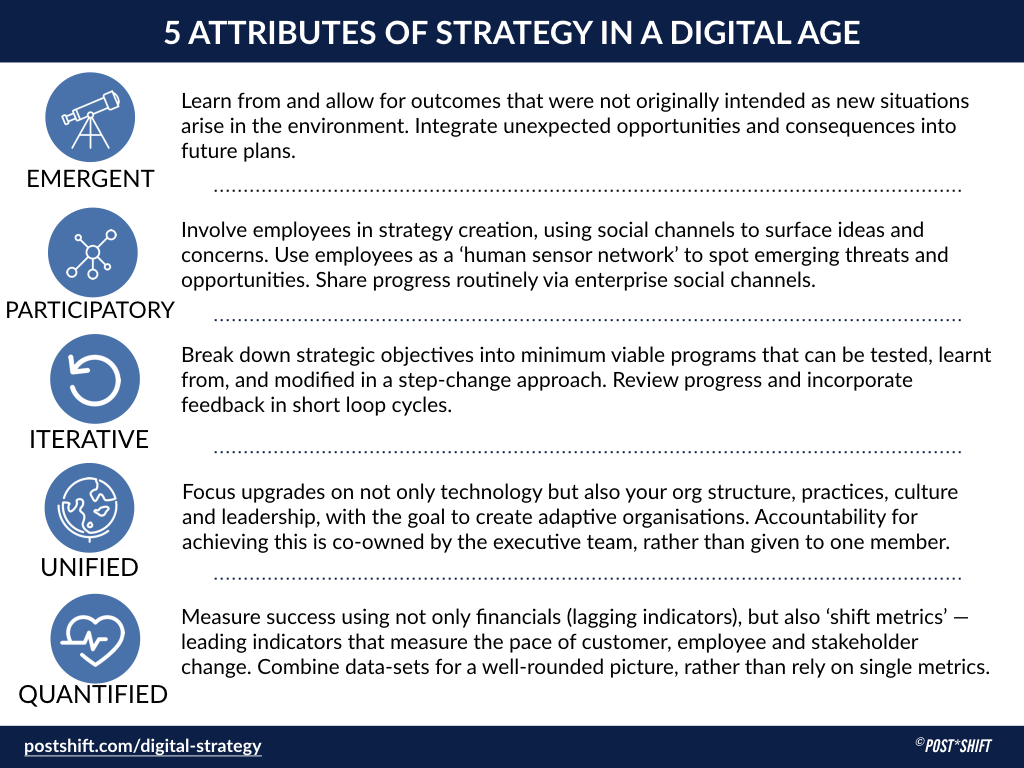Today, we are pleased to launch the latest Post*Shift research report on strategy in a digital age. Digital strategies have become ubiquitous. Regardless of industry, everyone is experiencing the rapid pace of change enabled by digitalisation. Large corporates have responded to this in the way they know best: with 3-5 year roadmaps, flashy communications campaigns, and gantt charts. But problems arise when companies apply these 20th Century tools to a 21st Century world. Instead, companies must learn to develop and execute their strategies in a new way that supports the constant need for adaptation and experimentation. For the report, we spoke with 18 Heads of Digital and CIOs at both large and small companies across a range of industries, as well as 3 software vendors with solutions to support new types of digital strategy management: Pinipa, Powernoodle, and Stormboard. We wanted to pinpoint how traditional approaches to strategy were failing and to surface more effective methods, in order to act as a guide to other organisations keen to break the cycle. Every executive we spoke with recognised the current failure of classic strategy creation and roll-out, and expressed varying degrees of frustration at attempts to find alternatives. One of the top-level findings, and a root cause of several pain points, was a continued insistence by many organisations on a bi-modal approach to digital, whereby it is separated from core operations. We saw this play out when digital strategy is created and executed at the edges of the organisation by dedicated Digital teams in protected labs or incubators. Confusingly, this execution takes place in support of digital vision statements that sound like they have come out of a buzzword generator, resulting in a paradox whereby digital seems to mean everything and nothing. It would be amusing if it was not so serious. The major impact of this imprecise, siloed approach is an employee base that struggles to connect the strategic objectives with their day-to-day work and behaviours. Nearly all of our interviewees identified a digital skills gap for what is needed to achieve their strategic goals, yet instead of finding ways to bridge the gap, we heard a perceived reluctance to trust that the wider employee base is even capable of doing so. Instead, organisations turn to start-up acquisitions or the hiring of visionary outsiders as their route to digital maturity. But this simply enhances the division, rather than addresses it, and has limited impact on long-term capability. Sooner or later the rest of the organisation must be given the support to develop the new skills needed to keep up. The five attributes of strategy in a digital age Our interviewees were painfully aware that traditional methods are not working, with many bearing the scars to prove it. However, despite this, we saw few alternative options available. Partly, we believe that this has to do with the need to appease a multitude of stakeholders both internal (employees), external (market) and the liminal space in between (investors and the board). Control still needs to be demonstrated to these groups even amongst the uncertainty. We believe the alternative lies in a shift in mindset, which starts with language. What is needed is not a ‘digital strategy’ but a ‘strategy in a digital age’. Do not mistake this for a minor tweak to words – it is actually a powerful reframing of what has become a meaningless platitude. It carries with it the implication that there is no longer a barrier between digital and the wider organisation, and demands a more connected approach that involves the entire organisation in developing its future. What makes a strategy suitable for the digital age? We scoured our interviews to find common requirements and cross-referenced this with our project experience and analysis from pioneering organisations to identify five common attributes:  How to make the shift Of course, understanding the new approaches to strategy management is only one part of the process. Practical transition methods are needed, grounded in the reality of corporate life and the challenges experienced by battling against legacy processes and assumptions ingrained in the muscle memory of organisations. Established companies do not have the luxury of just switching approaches overnight. This is why as part of the report we have also suggested step-change recommendations to enable you to take your first or next step in mastering strategy management in the digital age.
How to make the shift Of course, understanding the new approaches to strategy management is only one part of the process. Practical transition methods are needed, grounded in the reality of corporate life and the challenges experienced by battling against legacy processes and assumptions ingrained in the muscle memory of organisations. Established companies do not have the luxury of just switching approaches overnight. This is why as part of the report we have also suggested step-change recommendations to enable you to take your first or next step in mastering strategy management in the digital age.

